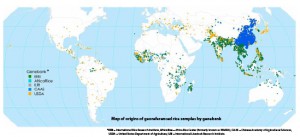- Japonica rice heads for the tropics for first time.
- Yet another Indian genebank opens its doors.
- And from somewhere else in India, we are alerted to the fact that today is International Seed Day.
- The biggest little olive farm in the world? Texas virgin on sale.
- Old endangered Norwegian cattle more efficient than modern breed. Genetics too.
- Foods, words, politics — a heady brew.
- Banana vs plantain. Jeremy says: Someone is wrong on the internet.
- Butterfly farming in Kenya under the spotlight. Again.
- Launch video of the expedition down the Congo river; agriculture only a pretty backdrop.
Nibbles: Aubergines, Opuntia, Amazonian ag, Kenya, Swiflets, Coconut and Web 2.0, PROTA, Mexico, Fruit wild relatives
- More either-or stuff from the Guardian on the Indian GM brijal story.
- The USDA prickly pear cactus germplasm collection gets some exposure. And how many times can one say that.
- Much better title from Discover on that ancient northern Amazonian earthworks story.
- Kenyan foresters tell people to eat bamboo. Luigi’s mother-in-law politely demurs. On the other hand, she might like this.
- Swiflet farming? Swiflet farming.
- Really heated exchange on paper on coconut lethal yellowing in Yucatan develops on Google Groups. I love the internet.
- PROTA publishes expensive book on promising African plants. Promises, promises. NASA promised us the personal jetpack. Where are we with that?
- Nice summary of that Mesoamerican agricultural origins story we blogged briefly about a few days ago. So what exactly do you call hunter-gatherers who also grow crops?
- First International Symposium on Wild Relatives of Subtropical and Temperate Fruit and Nut Crops will be held March 19-23, 2011 in Davis, California on the campus of the University of California, Davis. Book early.
International collections can’t do it by themselves
Two international centres tout their germplasm collections today. AVRDC’s newsletter, which I just got by email but can’t find on their website, gives a bit of a history lesson:
When AVRDC was founded in 1971, the Center started off with a modest collection of 570 accessions. By 1995, the genebank had grown to 43,205 accessions, comprising 63 genera and 209 species. To date, the Center has accumulated 57,230 accessions comprising 168 genera, 420 species from 154 countries of origin, a growth of 32.5% in number of accessions, 166.7% in number of genera, and 101% in number of species. AVRDC’s vegetable germplasm collections, held as an international public good for the world community, are growing in genetic diversity.
A further snippet of information shows yet again how interconnected the world is for genetic resources. Although “AVRDC is the largest holder of tomato germplasm,” it only includes “9% of the 83,680 accessions held worldwide.”
The same point is made, not quite so directly, but in a more visually striking way, in a map just out in Rice Today (click to enlarge):
And that, dear reader, is why we need a global system, and not just ever more genebanks.
Nibbles: Rice conservation and use, Tunisian genebank, Buno, Popcorn, Sustainability, Brazilian social networking, Strawberry breeding, Sunflower genomics, Climate change and fisheries
- Lots of Indian rice in the IRRI genebank. Any of it being used to develop drought-tolerant varieties?
- Lots of journalists in the Tunisian genebank.
- How they make coffee in Ethiopia.
- How they make popcorn the world over. You sometimes get popcorn (or popped sorghum) with coffee in Ethiopia, now I think of it. And since we’re on an Ethiopian kick, fancy some enjera? Gary Nabhan did.
- “Productivity vs. sustainability is a ‘false choice.’” Well I never. And probably not news to these people either, or these. But to these guys?
- A Twitter roundup from Embrapa.
- Ugly hybrid of two wild strawberries may cause allergies.
- Explanation of evolution of doubled genes in wild and cultivated sunflowers certainly causes pain in brain.
- Some good climate change news for the Atlantic croaker. Being a glass-totally-empty kinda guy I predict it tastes like shit.
Nibbles: Genebanks, Variety registration
- MSSRF’s big push to restore traditional rice varieties and other crops to farmers in Malabar.
- Abu Dhabi’s big push to genebank all its plant heritage.
- CAS/IP’s big push to learn from failure: papaya variety licensing.
